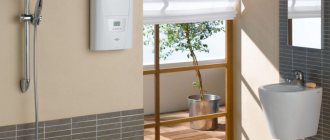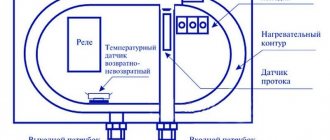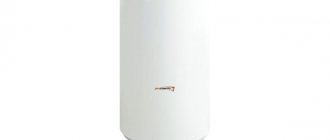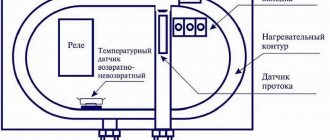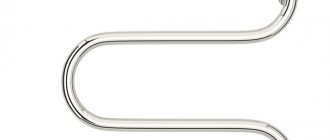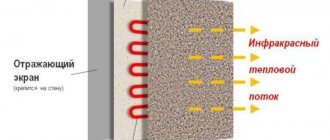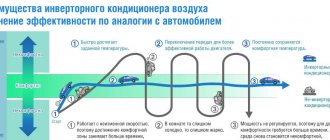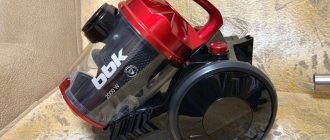Types of devices
When choosing a water heater for washing dishes, it is worth considering how actively you will use it and how much water you will need to use daily.
Many approach this issue too recklessly and decide to buy equipment without answering key questions for themselves. As a result, the operation of the device may not be satisfactory, the amount of water turns out to be insufficient, and other negative aspects also emerge. You probably don't want to encounter something like this. This is the case when it is better and preferable to learn from the mistakes of others rather than making your own. Still, a good water heater is not the cheapest thing, and the price can sometimes exceed 10-15 thousand rubles.
All existing water heaters, depending on their design features, are divided into 4 subcategories. Let's consider them separately.
Electric storage
Objectively, these are the most common types of water heaters, which are often referred to simply as a boiler. The electric heater is based on a special heat-insulated internal tank, the principle of operation of which resembles a thermos. That is, a certain water temperature is preserved and maintained inside.
The heating itself is carried out using heating elements (heating elements). Typically, the maximum temperature in electric boilers reaches 75 degrees Celsius, and can be adjusted depending on the model and at the discretion of the user, usually in the range from 30 to 75 degrees Celsius. When the set temperature is reached, the heating turns off. When cooling, the water heater turns on periodically to maintain the temperature.
The choice of boilers is very diverse in terms of volume. There are compact models with literally 10 liters. There are both 500 and 1000 liters. The most popular are containers of 50, 80, and 100 liters. The range of brands Electrolux, Zanussi, Ballu includes all the most popular displacements.
To heat water in water heaters, heating elements of appropriate power are used. Typically this is from 1.2 to 2.5 kW. The more powerful the heating element, the faster the heating. And of course, the heating rate is affected by the amount of water in the tank and its capacity.
Electric flow
A good option for the kitchen and shower if you need an independent water heater that will serve specifically for the benefit of one room. There is no storage capacity, so you can place it with your own hands in any convenient place, even under the countertop.
The water heats up instantly when you open the tap. And immediately heated water comes out of it. The degree of heating is controlled by changing the pressure supplied to the tap.
Cumulative: principle of operation
This water heating device works in a cumulative manner. Provides a tank (various in volume) that holds water. The heating device is a heating element. To operate, it is necessary to connect a cold water pipe to the device and connect it to the electrical network.
Water is drawn into the tank, heated and maintained at the set temperature. Used as needed. Automatically fills and ensures constant availability of a certain volume of water at the desired temperature.
There are the following varieties of this type of water heaters:
- Directly heated boilers - heating occurs due to the heating element, which requires a connection to the electrical network.
- Indirect heating boilers - mainly operate from central heating. And in the summer, when the heating is turned off, the water is heated using a heating element.
Types of water heaters
Depending on the principle of operation of the installation, water heaters are distinguished:
- Flow-through, from the name it is clear that in this case the water is heated on the go. This type of heater provides the fastest heating of water, but its temperature depends on many factors (water inlet temperature, device power).
- Cumulative - water is collected in a tank (container) in which standing water is heated and maintained at a given temperature.
See also -
How to choose a water heater for an apartment: expert advice
Rules for operating a storage water heater
Regular operation of a storage water heater requires a constant connection to the electrical network. This way, when the device cools down, it will be possible to heat the water to the set temperature without significant expenditure of electricity. At the same time, the filled tank is less susceptible to corrosion.
If the boiler is constantly turned off, savings cannot be achieved, because the equipment spends more electricity on heating the liquid. Disabling is possible with rare use (once a month).
A switched-off device cannot be left in an unheated room if the temperature in it drops below +5⁰ C. When choosing heating equipment for a summer house, this fact must be taken into account.
Instantaneous or storage water heater – which is better?
In order to correctly determine the type of water heating device (boiler) during the selection process, you need to familiarize yourself with the comparative characteristics of such equipment.
| Options | Type of equipment | |
| Instantaneous water heating device | Storage water heater | |
| Performance Metrics | Heating water to the required levels depends on the power level of the device | Optimal water temperature set on the device |
| Economical | Intensive consumption of electrical energy during use | Less intensive but continuous energy consumption |
| Dimensions and installation features | The need for a separate line and installation of an RCD, as well as grounding | Installation on a solid base such as a brick or concrete wall |
| Features of operation and maintenance | It may be necessary to replace the heating element | Periodic cleaning of the tank and replacement of the magnesium anode |
It should be noted that compliance with the installation and operation rules, as well as the presence of grounding and a protective shutdown system, make it absolutely safe and convenient to use both options for water heaters.
How to start a storage boiler
The first start-up of an electric water heater should be carried out by the installation technician immediately after installation of the device. His signature and the company’s seal in the technical passport and warranty card testify to the high-quality installation and commissioning. Without this procedure, warranty service for the boiler in the future is impossible.
Under conditions where it is impossible to invite a specialist to install and start the system, you have to connect the boiler yourself. Sequence of actions when starting for the first time:
Checking the quality of the water heater installation, determining leaks, if any:
- Disconnect the water heater from the power supply;
- Fill the water heating tank with water with the hot water tap open. After water starts flowing from the hot tap, you need to stop the water supply, since the tank is already full;
- Close the tap, it is advisable to leave the boiler for a while;
- Inspect the water heating structure. Determine the integrity of the connection elements. If there are no leaks, you can connect the device to the power supply. Leaks must be eliminated.
- Connect the boiler to the power supply and set the heating mode.
- Make sure, by checking the technical documentation, that the amount of time spent on heating corresponds to the norm, and the water is at the required temperature.
After a long shutdown of the boiler (winter period at the dacha, use in the apartment when the hot water supply is turned off), the start-up is carried out according to the given scheme.
Video - Which is better: a gas water heater or a boiler?
Which water heater should you choose? We recommend doing this - for home and large families, especially if you want to use the device all year round, choose a drive. A flower is a good solution for a summer house or small apartment during a short shutdown of hot water supply. The main thing is to consider the features of the room and the amount of water you use during the day. And be sure to follow the operating rules for liquid heating devices.
Strengths and weaknesses of an electric instantaneous water heater
And so, based on the principle of operation and design features, the obvious advantages of the flow type will be as follows:
- A large tank with thick thermal insulation is not needed, so the water heater is a small product for which you can easily find a place even in the tightest room.
- The previous point implies a reduction in the cost of the device.
- Due to its small size and weight, an instantaneous water heater is much easier to install than a boiler.
- The flower can supply hot water without interruption and for as long as desired. In the case of a boiler, after the supply of heated water has been used up (for example, the user has taken a shower or filled the bath), he has to wait quite a long time for a new portion to heat up.
- The heat produced by the flower is immediately used for its intended purpose, while a boiler that is in standby mode with a significant supply of hot water, even with the thickest thermal insulation, loses some of the heat.
But it is impossible not to note some features of such devices:
Heating water in flow mode requires significant power. The weakest of the flow generators consume 3.5 kW of electricity. More powerful devices - 5 or 7 kW. Conventional apartment wiring, as a rule, is not designed for such a load (with the exception of houses with electric stoves), so you have to pull a separate wire from the switchboard. This nuance should be taken into account when choosing a flower.
A simple formula from a school physics course will help you really evaluate the performance of an instantaneous water heater:
Q = c * m * dT,
- Q—water heater power, W;
- C is the heat capacity of water, we take c = 4200 J/kg* 0 C;
- M is the mass of water flowing through the device in 1 second, kg/sec (this is the same as l/sec, since 1 liter of water weighs 1 kg);
- dT - temperature difference, 0 C.
When passing through an instantaneous water heater, the water heats up instantly
From the above formula we determine the per second productivity:
M = Q / (c * dT).
It is easy to calculate that in winter, when the temperature of the water in the water supply drops to +7C, a 7 kW water heater will be able to heat it up to +40C (temperature comfortable for taking a shower) with the productivity:
M = 7000 / (4200 * (40 – 7)) = 0.05 l/sec = 3 l/min.
Thus, for permanent use, a boiler, that is, a storage water heater, can be considered more practical.
Design and features
The design of an instantaneous water heater is not particularly complicated. A single scheme is used here for all models: cold water passes through the body of the product, where the heating element gives it its heat. The user has just opened the tap - a relay inside the device is instantly activated, which is responsible for the pressure, and within a few seconds the water is heated to the desired temperature (depending on the power of the heating element), which is set manually.
Inside, the instantaneous water heater is equipped with a special breaker that immediately turns off the power if the water temperature rises sharply and becomes much higher than the critical level. From possible pressure drops inside the water supply, which can happen at any moment, the product is reliably protected by a built-in stabilizer.
Water heaters of this type differ in the type of heater and control system.
Heater types
As the main component of the design of all electrical appliances, the heater is usually produced in the form of a spiral or heating element. In products with a non-insulated spiral, it is placed in a special block of plastic tubes, located inside a housing made of very durable plastic. When such a device is connected to the network, the coils heat up, and the passing flow of water takes away this heat. Due to the small volume of water in the container and the small mass of the entire device, no residual heat generation occurs after shutdown, so scale does not form. Such products are used to heat water in swimming pools; in everyday life they should be used in regions with very hard water.
Closed heating elements work on the same principle, heating the flow of water passing through them, but their spiral is enclosed in a copper or brass housing, so in a fire safety sense they are much more reliable than the first option.
Control system
Instantaneous water heaters can be divided according to the type of control they have.
- Hydraulic - this type is less accurate, it has 6 power levels, switching is done manually using a switch.
- Electronic type - the thermostat controls the heating independently, users only set the temperature acceptable to them. This type of control is considered very convenient.
When using a mechanical control option, a hydraulic unit with a membrane is located inside the product, which turns the device on or off depending on the water pressure.
Electronics controls the entire process using a microprocessor, and special sensors help it provide any temperature, regardless of pressure, and it also sets optimal power, significantly reducing electrical energy consumption.
Design and mechanism of operation
The most commonly installed water heating appliances are those whose operation is ensured by burning gas or using electricity.
It is quite rare to find equipment operating on liquid or solid fuel.
Electric water heaters are installed in the absence of a centralized gas main, in urban and suburban conditions.
This type of devices is represented by flow-through and storage models, differing in functionality, design features and mechanism of action:
- The design of flow-through models is represented by a housing and a protective system, a terminal block, a pipe for supplying cold water, a heating element in the form of a heating element, as well as a control system, a pipe for hot water intake and a transformer. Flow-through electric water heaters can be non-pressure or pressure. The first option is used in showers and in the country, it is characterized by not too high energy consumption and, accordingly, a low power level. Pressure equipment is distinguished by the ability to regulate the temperature of water heating.
- The design of reliable and economical storage models is represented by a housing, a reservoir, a heat-insulating layer, a magnesium or titanium anode and a heating element, a thermostat and a control unit, as well as a safety group and a temperature sensor, an indicator and an electrical cable. A significant part of electric storage-type models consume no more than 2 kW of electricity in the process of heating water.
It should be noted that the main difference affecting the choice of equipment type is the amount of energy consumed. Flow-through models use about 25-30 kW, which is due to the instant heating of water passing through the heating element.
Instant water heating is one of the advantages of an electric instantaneous water heater
As practice shows, for the operation of a flow-through heater, it is necessary to provide an electrical supply with a voltage of 380 V. Among other things, the difference between such water heating equipment is the supply of hot water exclusively to one point.
The most economical to operate is still time-tested, but improved, gas-type water heating equipment.
Operating principle of instantaneous water heater
A potential buyer should know that flow machines are divided into two groups, which work slightly differently:
Pressure type
Such a water heater cuts into the water supply somewhere before the branch, so that hot water can be supplied to several water points. When the taps are closed, it experiences the pressure of the water supply, which is why it is called pressure.
Schematic diagram of installation of a pressure instantaneous water heater
Gravity type
In everyday life they are often called “tap water heaters” or “heated mixers”. To connect such a device, a tee is cut into the water supply, and a tap is screwed to the tap. The water heater is connected to this tap. Thus, only one hot water tap will be available. The most convenient way is to connect to the outlet on the washing machine, to which you just need to screw a tee.
It’s even easier to connect to the nozzle on the mixer, to which the hose with the shower head is screwed. True, this option will not be very convenient to use: the standard shower hose and the water heater connection will have to be alternately screwed on and unscrewed.
Non-pressure flow units are equipped with a spout (this element is also called a gander) and a shower head of a special design, which ensure a comfortable water supply at low flow rates. If you connect a regular shower head to the water heater, the water will flow out of it not in a “rain”, but in one stream. If you increase the flow rate, “rain” will appear, but the water will become cool.
The spout and watering can supplied with the water heater are not only designed for low flow, but also have structural elements that allow you to regulate the flow while maintaining the jet parameters.
In this case, the flow rate will change (and with it the temperature), but the water will flow out in the form of “rain” in any case. The spout can be adjusted in the same way, only the nozzles for it are replaceable.
An electric water heater is convenient to use in a country house, in a private home of permanent residence, when there is no gas mains or hot water supply. Reasonable cost (compared to gas) also plays an important role when purchasing and often preference is given to an electric heater. At the same time, it must be remembered that proper operation of the device is the key to long-term, uninterrupted service.
Comparative analysis of flow-through and storage boilers
Both types of devices differ in many parameters: price, power consumption, size. Both instantaneous and storage water heaters have their pros and cons. Factors that significantly influence the operation of the equipment are presented below.
Performance per number of users
The dimensions of storage heaters depend on the volume of the selected tank. To correctly determine the required amount of hot water per family, you can use the table:
| How many people use the boiler? | What needs is the heater used for? | Recommended storage tank volume |
| one adult | kitchen sink | 10-15 l |
| one adult | shower, sinks in kitchen and bathroom | 30-50 l |
| two adults | shower, sinks in kitchen and bathroom | 50-65-80 l |
| two adults and a child | shower, bathtub, kitchen and bathroom sinks | 80-100 l |
| three adults and a child | shower, bathtub, kitchen and bathroom sinks | 100-120-150 l |
| four adults and a child | shower, bathtub, kitchen and bathroom sinks | 150-200-300-500 l |
The performance of a flow-through boiler is calculated by the flow rate. A low-power technique will produce a thinner stream of water. You can calculate your comfortable speed by placing a bucket under the tap and measuring how much liquid flows out in one minute.
The required performance is calculated from the speed using the appropriate formula:
where W is the heater power in kW;
T1 – temperature of incoming fresh water (for central Russia in winter – about 0 degrees Celsius, in summer – about 15 degrees Celsius);
T2 – temperature set for the heater.
In order not to get involved in calculations and measurements, you can read the instructions for specific models. It is customary among manufacturers to indicate the area of use of the boiler, as well as the number of liters that the device can heat in a minute.
Dimensions and weight
If you have little space and don’t want to lift heavy objects, you should give preference to instantaneous water heaters. They weigh no more than two kilograms. The overall dimensions of such equipment do not exceed half a meter in length and fifteen to twenty centimeters in width. Such equipment is easy to install even in a small room.
Storage boilers can reach a meter in length. These systems are most often installed in spacious rooms, or using the available space wisely.
Electricity consumption and price of heaters
What is more profitable: instantaneous water heater or storage boiler? Often, potential buyers refuse to even think about a flow apparatus due to high energy costs. However, this approach has disadvantages. Since school, physics has been saying that to raise the temperature of one liter of water, regardless of the type of device, the same amount of energy will be required. Thus, the total energy consumption of a flow device will be less than that of a storage device. After all, the second one spends energy not only on increasing the temperature of the water, but also on maintaining its level.
It is useful to pay attention to the energy saving class of the heater: many modern models are equipped with an “economy mode”. It is designated by the letter “E” and implies that less energy will be wasted.
A little advice: if such a mode is not provided, the user can set the temperature to 50-55 degrees Celsius, which will help save electricity.
If we talk about the cost of water heaters, storage devices most often cost the buyer more than instantaneous ones. Although we should not forget that everything depends on the brand and model. You can find out more about the prices for water heaters in our online store.
In addition, flow technology does not require expensive maintenance. If you take care of the presence of a filter for the incoming water, then you will not have to open the device more than once every couple of years. At the same time, storage equipment must be regularly drained and cleaned of accumulated sediment. This operation is carried out at least once a year and often requires replacing the magnesium anode with a new one. Failure to maintain systems will lead to an increase in water heating time and a drop in outlet temperature, and ultimately to equipment failure.
It is worth remembering that even if you strictly follow the recommendations for caring for a storage boiler, it will not last much more than a decade. The operating life of flow-through devices is usually much longer.
Security
Flow heaters are three-phase technology. They require separate wiring, a residual current device, and grounding. If the listed systems are installed incorrectly or are not installed, an accident may occur that will cost a person his life.
Heaters with a storage tank do not require the installation of additional systems; their safe operation is limited to following the instructions. It is important to remember that the device can only be disassembled and cleaned after disconnecting it from the power supply.
Installation and connection to pipelines
To install a storage heater, you will need a team of at least two people. In this case, one will hold the unit, and the second will secure it in place. To install the device, you must use holding elements, such as anchors, which are sold complete with the heater. After installation, the storage boiler must be filled with liquid, connected to the network, and then warmed up to ensure that the system is working properly. Do not forget that when filled, such a heater weighs quite a lot.
Such a system is simply connected to the pipeline: on the body of the storage tank there are two labeled pipes, one for hot water and one for fresh. It is quite difficult to confuse them.
The instantaneous boiler can be installed discreetly. It is not necessary to use special fasteners and anchor bolts. Modern instantaneous heaters are connected as easily as storage heaters: an inlet water pipe plus an outlet pipe. Installation of a geyser is carried out by licensed specialists after obtaining permission.
